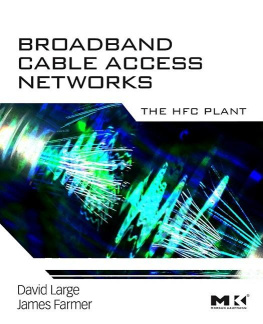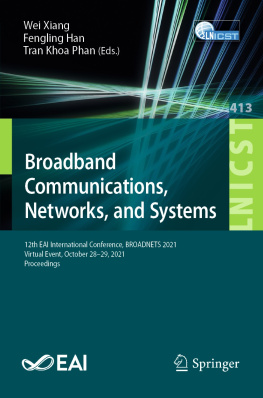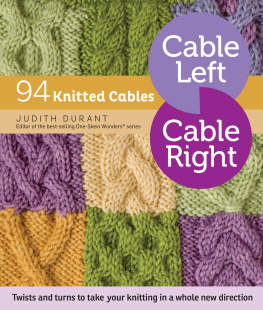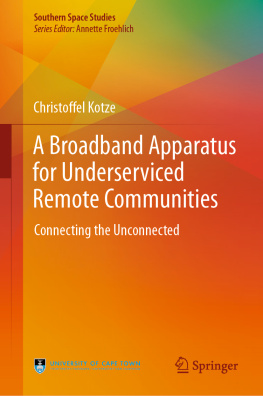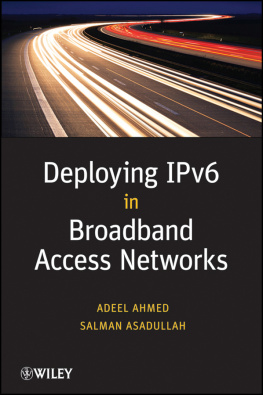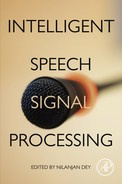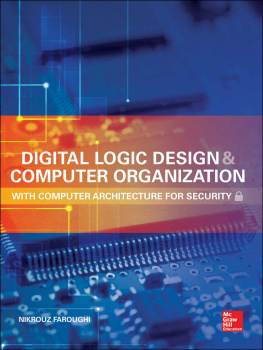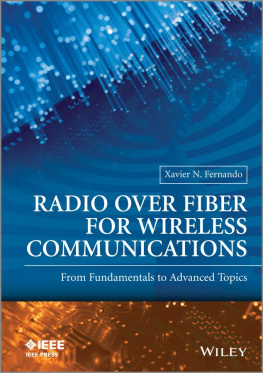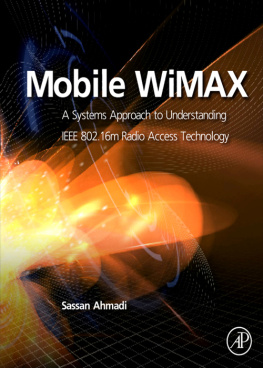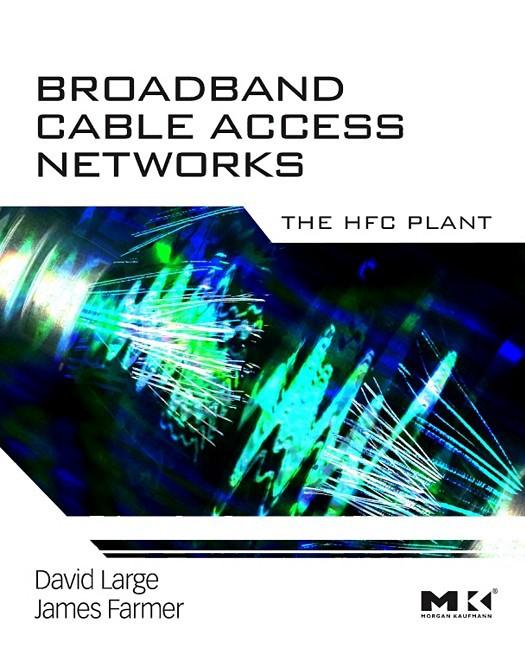Broadband Cable Access Networks
The HFC Plant
David Large
James Farmer
Brief Table of Contents
Table of Contents
Copyright
Morgan Kaufmann Publishers is an imprint of Elsevier.
30 Corporate Drive, Suite 400
Burlington, MA 01803
This book is printed on acid-free paper.
Copyright 2009 by Elsevier Inc. All rights reserved.
Designations used by companies to distinguish their products are often claimed astrademarks or registered trademarks. In all instances in which Morgan KaufmannPublishers is aware of a claim, the product names appear in initial capital or all capitalletters. Readers, however, should contact the appropriate companies for more completeinformation regarding trademarks and registration.
No part of this publication may be reproduced, stored in a retrieval system, or transmitted in any form or by any means, electronic, mechanical, photocopying, scanning, or otherwise, without prior written permission of the publisher.
), by selecting Support & Contact then Copyright andPermission and then Obtaining Permissions.
Library of Congress Cataloging-in-Publication Data
Large, David, 1940
Broadband cable access networks : the HFC plant / David Large, James Farmer.3rd ed.
p. cm. (Morgan Kaufmann series in networking)
Includes bibliographical references and index.
ISBN 978-0-12-374401-2 (alk. paper)
1. Cable television. 2. Broadband communication systems. 3. Optical fiber communication. I. Farmer, James. II. Title. III. Title: Broadband cable access networks, the hybrid fiber/coax plant. IV. Title: Broadband cable access networks, the hybrid fibre/coaxial plant.
TK6675.L37 2008
621.38857dc22
2008034236
For information on all Morgan Kaufmann publications, visit our Web site at www.mkp.com or www.books.elsevier.com.
Printed in the United States
08 09 10 11 12 10 9 8 7 6 5 4 3 2 1
Acknowledgments
Much of the material in this book is based on the transmission system portion of our previous book, Modern Cable Television Technology, Second Edition. The material has been updated and expanded to reflect changes that have taken place in the broadband industry in the intervening four years. As with our previous works, we freely acknowledge that we stand on the shoulders of our associates, our mentors, and those who have developed and documented cable television technology.
We owe a continuing debt of gratitude to those who contributed to previous books and, additionally, to those who agreed to review the proposal and scope of this current work, including Michael Adams, Vice President of System Architecture, Tandberg TV/Ericsson Group; Dan Pike, Chief Technology Officer of GCI Cable; Joseph Van Loan, Consultant and Chair of the Xtend Networks Advisory Board; and Ray Thomas, Principal Engineer, Advanced Technology Group, Time Warner Cable; Dr. John Kenny, Wave7 Optics, an Enablence Technologies Company; and Dr. Lamar West, Cisco Systems.
We are particularly indebted to Ron Hranac, who currently works at Cisco and is Senior Technology Editor of Communications Technology, for his careful review of the entire book prior to publication.
Additionally, specific recognition is due to many whose work is reflected in these pages more directly. In most cases, the endnotes for each chapter document where the work of other authors and researchers has been quoted or characterized. Additionally, we acknowledge the following:
- is based on data furnished by Howard Carnes of Antec Corporation.
- is based on a figure in Ronald C. Cotten, Lightwave Transmission Applications, September 15, 1993 (p. 108). The graph is used with permission of CommScope, Inc., and Cable Television Laboratories Inc., Louisville, CO.
- are based on figures in Dogan A. Atlas, Fiber-Induced Distortion and Phase Noise to Intensity Noise Conversion in Externally-Modulated CATV Systems, 1996 National Cable Television Association Technical Papers, April 1996 (pp. 291292). Washington, DC: National Cable Television Association.
- are adapted from material furnished by CableAML, Inc., Torrance, CA, September 5, 1997.
Finally, we are indebted to the staff at Morgan Kaufmann/Elsevier for their support and encouragement, including Rick Adams, senior acquisitions editor, who identified the need for a book aimed specifically at those who work with linear distribution systems; Maria Alonso, assistant editor; and Marilyn Rash, project manager.
About the Authors
David Large is an independent consultant whose career has included building and operating cable systems; designing products for the industry; and advising a wide variety of firms, governments, and organizations. He is a Fellow Member and Hall of Fame Honoree of the STCE, a Senior Member of the IEEE, an NCTA Science and Technology Vanguard Award Winner, and an SCTE-certified Broadband Communication Engineer.
James Farmer is Chief Technical Officer at Wave7 Optics, an Enablence Technologies Company. He has previously been with Scientific-Atlantic, ESP, and ANTEC. Jim is a Fellow of the IEEE and a Senior Member the SCTE and has served on administrative boards with both organizations. He is the recipient of the NCTA Vanguard Award in Technology and a member of the SCTE Hall of Fame.
Chapter 1. Linear Broadband Distribution Systems
1.1. Introduction
Cable television systems have moved far beyond simple delivery of television programming to include high-speed data services, voice telephony, networking, transactional delivery of digital video under the interactive control of customers, and targeted advertising delivery, to name a few. To manage this complex business, what was formerly known simply as the headend has also evolved into a hierarchy of national, regional, and local signal processing centers. Similarly, the subscriber's premise has evolved to often include local distribution networks that allow communication among devices as well as with the external network. In the near future, communications will be provided by operators to multiple, diverse end terminals, including wireless devices. Our previous book, Modern Cable Television Technology: Voice, Video and Data Communications, 2nd ed. (Morgan Kaufmann, 2004) covered the entire range of technologies involved in a cable system and should be consulted for topics lying outside the scope of this volume.
At some point in this network, the modulated radio frequency (RF) signals that are to be transported to customer homes are delivered to a linear distribution network whose purpose is to deliver those same signals with no further per-signal processing and with as little degradation as economically possible. This book is devoted to that portion of the system, which we have referred to generically as the hybrid fiber/coax (HFC) plant, although it need not always include both fiber optics and coaxial transport and may occasionally include microwave links.
The HFC plant is designed to be as transparent as possible and is characterized by its bidirectional RF bandwidth, the maximum level of various impairments to the transported signals, the number of homes or customers who share common signals, its reliability and availability, and its ability to scale to provide greater per-subscriber bandwidth as needed.
It is this portion of a cable television system that distinguishes it from, for instance, a direct-to-home satellite system; that is, a satellite provider is limited to a one-way broadband path that, because of the characteristics of satellite antennas, delivers signals in common to millions of homes and, because of the characteristics of those signals, requires signal processing for every in-home television receiver. Because of the limitations of its networks, direct broadcast satellite (DBS) systems are practically limited to video distribution as their primary business.

